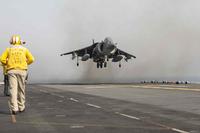The enormous need for overhead reconnaissance to combat IEDs and to track terrorists and insurgents over large areas for long periods is driving at least one part of the Pentagon to develop so-called stratospheric UAVs that can hover above the Jet Stream for several months or more.
And that may be the harbinger of a long-term shift in the UAV market, according to one advocate of the concept, Ed Herlik. He's the lead author of a market forecast report titled "Unmanned Aerial Vehicles (UAVs) for Counter-Insurgency Global Market & Technologies Outlook 2010-2015," produced by Market Intel Group, where Herlik is a partner.
The report predicts persistent stratospheric UAVs will significantly change the marketplace for both platforms and payloads in less than five years. "Persistent surveillance (months or a year on-station above the Jet Stream) is the one capability that will significantly enhance the ability to combat an insurgency while minimizing troop risk and ground commitment," the report says.
Aerostats are tied to the ground and so don't rise high enough. Balloons float with the wind and so can't persist over a target. Air ships, blimps or whatever you want to call them are driven by propellers and so can sometimes hold position against the wind. Near-Space UAVs will sail above the Jet Stream, between 50,000 and 70,000 feet, where there is relatively little wind -- around 30 knots on average.
Herlik has been here before. He pushed the concept of near-space UAVs when he was at Air Force Space Command. He was pushed out and the concept, which had had support from top service leadership, pretty much died.
But he says that a part of OSD, which he would not identify, is eager to go ahead and build at least one of these ships. The "entity" likes the UAVs because they of two compelling qualities; they can produce a great deal of solar-generated electric power to ensure lightweight sensors can operate for very long periods and they can stay on station for a hell of a long time at pretty small cost. It would not surprise me if it's the "entity" is JIEDDO, given the increasing deaths this year from IEDs and its relative freedom from service constraints. Herlik told me the entity, whatever it is, does not plan to go through the Air Force. "They're not waiting for a ride on someone else's UAV given that the usual acquisition process will take years longer to do what can be done now," he said. As Herlik reminded me, the Air Force -- aside from its brief flirtation with the concept when he was there -- has either been disinterested or in outright opposition.
Pentagon acquisition czar Ash Carter has voiced very public support for aerostats as an affordable tool for IED detection and more general ISR work, most lately in early April at the Center for Strategic and International Studies. "We are going to be this summer increasing manifold the number of aerostat-borne cameras," Carter said. They provide “the same functionality as a UAV would have, but it's something we can afford to get in there this summer.”
Herlik believes a near-space UAV can be built from start to prototype in six months, with a deployable version six months after that for $3 million to $5 million. The Southwest Research Institute has built HiSentinel [pictured] and tested it. Lockheed Martin has been working on aerostats and various other types of blimps and airships for almost a decade. One of their most recent entries is the DARPA program known as Integrated Sensor Is Structure ((ISIS).








